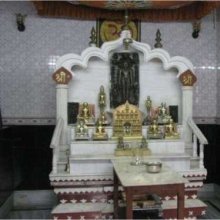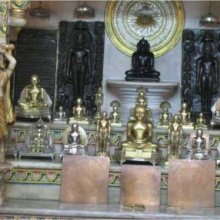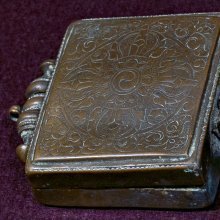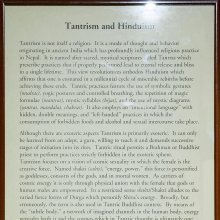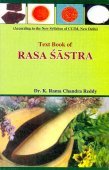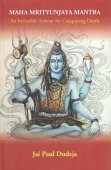Yantra, Yamtra: 44 definitions
Introduction:
Yantra means something in Buddhism, Pali, Hinduism, Sanskrit, Jainism, Prakrit, the history of ancient India, Marathi, Hindi. If you want to know the exact meaning, history, etymology or English translation of this term then check out the descriptions on this page. Add your comment or reference to a book if you want to contribute to this summary article.
Images (photo gallery)
In Hinduism
Ayurveda (science of life)
Rasashastra (Alchemy and Herbo-Mineral preparations)
Source: Academia.edu: Ayurveda and Pharmaceutics (rasashastra)Yantra.—The production of herbo-mineral or mineral medicines needs immense power that cannot be generated by hitherto techniques. Therefore, the ayurvedic physicians have devised special yantras that generate immense heat to treat the minerals at high temperatures. Yantra is an appliance or mechanical contrivance that helps ‘purify’ raw minerals and formulate medicines of bio-mineral or mineral substances. Tens of varieties of yantras were described in the medieval ayurvedic texts. These yantras are made out of simple earthen ware, but subjected to intense heat during few days. The mercury and other alchemical products that are bound within the yantras undergo metamorphosis under duress and yield final product in very fine form.
Unclassified Ayurveda definitions
Source: Google Books: Exploring Mantric AyurvedaYantras or the geomentrical symbols for the mantras can be used along with mantras and also to empower the gemstone, for both the Deity and Planet which gives them a better energy (one can place the sones on an energised yantra for empowering gemstones for healing).
Source: gurumukhi.ru: Ayurveda glossary of termsYantra (यन्त्र):—Instrument; equipment; Machine

Āyurveda (आयुर्वेद, ayurveda) is a branch of Indian science dealing with medicine, herbalism, taxology, anatomy, surgery, alchemy and related topics. Traditional practice of Āyurveda in ancient India dates back to at least the first millenium BC. Literature is commonly written in Sanskrit using various poetic metres.
Purana and Itihasa (epic history)
Source: archive.org: Shiva Purana - English TranslationYantra (यन्त्र) refers to a type of ritualistic worship, as mentioned in the Śivapurāṇa 1.10. The rites of worship are performed in accompaniment with Tantra, Yantra and Mantra appliances. Yantra is a mystical diagram possessed of occult powers. Tantra is a ritual, the chief peculiarity of which is the worship of the female energy of Śiva. personified in the person of his Śakti. This special energy, the Śakti of Śiva is concerned with sexual intercourse and magic power. Mantra is a magical formula.
Source: Cologne Digital Sanskrit Dictionaries: The Purana IndexYantra (यन्त्र).—A mechanical contrivance used by Tvaṣṭā to diminish the tejas of the sun; the surplus tejas became Viṣṇu's cakra, Rudra's trident and Indra's thunder bolt.*
- * Matsya-purāṇa 11. 27-9.

The Purana (पुराण, purāṇas) refers to Sanskrit literature preserving ancient India’s vast cultural history, including historical legends, religious ceremonies, various arts and sciences. The eighteen mahapuranas total over 400,000 shlokas (metrical couplets) and date to at least several centuries BCE.
Ganapatya (worship of Ganesha)
Source: Google Books: Ganapati: Song of the SelfYantra (यन्त्र) refers to a “geometrical design” and is associated with the worship of a deity (pūjā).—Yantra (or cakra) is a geometrical design with mystic significance for every part of it. The deity is believed to reside in the yantra.
Ganapatya (गाणपत्य, gāṇapatya) represents a tradition of Hinduism where Ganesha is revered and worshipped as the prime deity (ishta-devata). Being a minor though influential movement, Ganapatya evovled, llike Shaktism and Shaivism, as a separate movement leaving behind a large body of literature.
Kavya (poetry)
Source: archive.org: Naisadhacarita of SriharsaYantra (यन्त्र) refers to a “device” (viz., for extracting oil from mustard and sesamum seeds), and is mentioned in the Naiṣadha-carita 10.6; 22.87.—In verse 22.150, yantra means “a boring instrument”.
Source: academia.edu: Bhoja’s Mechanical GardenYantra (यन्त्र) (“machines” or “mechanical devices”) were also known in India from early times. Treatises on polity and war described the use of different types of yantras in warfare. Many yantras were particularly associated with gardens (lending further credence to the garden as a place of human artifice), because the manipulation of water flows formed one of the chief sources of power for mechanical devices. In gardens it was most often used to create fountains and water jets—the fountain (jalayantra) and fountain house (yantradhārāgṛha) were themselves considered mechanical devices, as their very names make plain. Even animal and human automata-like objects were apparently not unknown.

Kavya (काव्य, kavya) refers to Sanskrit poetry, a popular ancient Indian tradition of literature. There have been many Sanskrit poets over the ages, hailing from ancient India and beyond. This topic includes mahakavya, or ‘epic poetry’ and natya, or ‘dramatic poetry’.
Vastushastra (architecture)
Source: academia.edu: Bhoja’s Mechanical Garden (vastu)Yantra (यन्त्र) (“mechanical devices”) is dealt with in he Samarāṅganasūtradhāra: a prescriptive treatise on architecture attributed, like the Śṛṅgāramañjarīkathā, to king Bhoja of Dhārā. It includes a substantial chapter, of some 220 verses, on the classification, construction, and use of a wide variety of mechanical devices (yantras), including a number of automata that appear to closely match the literary descriptions from the Śṛṅgāramañjarīkathā and Yaśastilakacampū. [...] We have, in other words, the appearance of a common literary/practical theme in texts composed within an approximately 150-year span (ca. 950–1100 CE) all in central/western India. Moreover, it suggests that the descriptions of the Yaśastilakacampū and Śṛṅgāramañjarīkathā were likely part of a wider interest in automata that was not simply literary but included, at least notionally, the possibility of real-world technologies.

Vastushastra (वास्तुशास्त्र, vāstuśāstra) refers to the ancient Indian science (shastra) of architecture (vastu), dealing with topics such architecture, sculpture, town-building, fort building and various other constructions. Vastu also deals with the philosophy of the architectural relation with the cosmic universe.
Jyotisha (astronomy and astrology)
Source: Wisdom Library: Brihat Samhita by VarahamihiraYantra (यन्त्र) refers to “(the science of) mechanics”, according to the Bṛhatsaṃhitā (chapter 16) (“On the planets—graha-bhaktiyoga”), an encyclopedic Sanskrit work written by Varāhamihira mainly focusing on the science of ancient Indian astronomy astronomy (Jyotiṣa).—Accordingly, “Mercury presides over the western half of the Lohitya river, [...] people living on table lands, on the surface of water, in valleys (bila) and in mountains; over persons possessing a knowledge of the laws of drink, of mechanics (yantra), of music, of writing, of gems, of colour and of perfumes; [...]”.
Source: Google Books: Studies in the History of the Exact Sciences (Astronomy)Yantra (यन्त्र) refers to an “instrument”, according to the Ghaṭikāyantraghaṭanāvidhi, an unpublished manuscript describing the ritual connected with the setting up of the water clock and its invocation.—Accordingly, “[...] Now another method. After carefully observing the rise of the Sun’s orb up to the half, or the setting of the same, the instrument [i.e., yantra] (i.e. the bowl) should be placed in a basin filled with water. The bowl is so made that its height is equal to six aṅgulas, and the circular opening is twelve aṅgulas in diameter”.

Jyotisha (ज्योतिष, jyotiṣa or jyotish) refers to ‘astronomy’ or “Vedic astrology” and represents the fifth of the six Vedangas (additional sciences to be studied along with the Vedas). Jyotisha concerns itself with the study and prediction of the movements of celestial bodies, in order to calculate the auspicious time for rituals and ceremonies.
Shaktism (Shakta philosophy)
Source: Google Books: ManthanabhairavatantramYantra (यन्त्र) refers to “magical devices”, according to the Ṣaṭsāhasrasaṃhitā, an expansion of the Kubjikāmatatantra: the earliest popular and most authoritative Tantra of the Kubjikā cult.—Accordingly, “She is the Vidyā of twenty syllables well known as Amarikā. She destroys the magical devices (yantra) of others and (is used) to catch the wicked, remove fever, paralyse speech, the mouth and armies. She is the goddess Amarikā present in the intense union with the Yoginīs (haṭhamelaka)”.
Source: Shodhganga: Kasyapa Samhita—Text on Visha Chikitsa (shakta)Yantra (यन्त्र) refers to the “visual form of a deity” (which annihilates all evils), according to the Kulārṇava-tantra (verse VI.85ab, 86cd-7).—The deity, pleased when propitated in the form of Yantra, is like the soul to the body and oil to the lamp. All deities can be invoked in Yantra and worshipped after receiving instruction or dīkṣa from a preceptor.

Shakta (शाक्त, śākta) or Shaktism (śāktism) represents a tradition of Hinduism where the Goddess (Devi) is revered and worshipped. Shakta literature includes a range of scriptures, including various Agamas and Tantras, although its roots may be traced back to the Vedas.
Vedanta (school of philosophy)
Source: Prem Pahlajrai: Pañcadaśī Chapter 7: Tṛptidīpa PrakaraṇamYantra (यन्त्र) refers to a “machine”, according to the Pañcadaśī verse 7.140-141.—Accordingly: “What is there attractive in the cage‐like body, ever restless like a machine [i.e., yantra], of a woman who is but a doll made of flesh and consisting of nerves, bones and joints? Such are the defects of worldly pleasures, elaborately pointed out by the scriptures. No wise man, aware of these defects, will allow himself to be drowned in afflictions caused by them. [...]”.
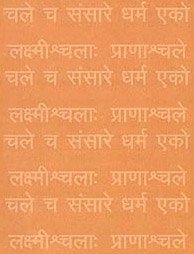
Vedanta (वेदान्त, vedānta) refers to a school of orthodox Hindu philosophy (astika), drawing its subject-matter from the Upanishads. There are a number of sub-schools of Vedanta, however all of them expound on the basic teaching of the ultimate reality (brahman) and liberation (moksha) of the individual soul (atman).
Shaivism (Shaiva philosophy)
Source: Brill: Śaivism and the Tantric TraditionsYantra (यन्त्र) (Cf. Yantrakarman) refers to “two-dimensional figures”, according to the Brahmayāmala-tantra (or Picumata), an early 7th century Śaiva text consisting of twelve-thousand verses.—While worship (yāga, yajana) provides the essential paradigm for the Brahmayāmala’s integration of inner and outer ritual, the principle and practice of their integration applies more widely. This is abundantly evident in the domain of “magic,” including all manner of rites involving alphabetical wheels (cakra), images of the deities (pratimā), and two-dimensional figures (yantra). These processes may entail, for example, the fusion of the channels of one’s own body with the spokes drawn in the lotus of a cakra—the term nāḍī refers to both—which may then be fused with the channels of the targeted victim (sādhya).
Source: SOAS University of London: Protective Rites in the Netra TantraYantra (यन्त्र) refers to a class of “mystical diagrams”.—The terms maṇḍala, cakra, and yantra are each often translated as “mystical diagram”. These diagrams serve as spaces for ritual practice and are created so that the deities can appear within them. Each type has its own frequent characteristics... Yantras are small, usually portable diagrams that utilize geometric patterning. Further, yantras can be two- or three-dimensional, while maṇḍalas are mostly two-dimensional.

Shaiva (शैव, śaiva) or Shaivism (śaivism) represents a tradition of Hinduism worshiping Shiva as the supreme being. Closely related to Shaktism, Shaiva literature includes a range of scriptures, including Tantras, while the root of this tradition may be traced back to the ancient Vedas.
Nirukta (Sanskrit etymology)
Source: Shodhganga: Kasyapa Samhita—Text on Visha Chikitsa (nirukta)Yantra (यन्त्र) is derived from the root ‘yam’, which means sustain or support, with the suffix ‘tra’ which means an instrument, device, or tool to serve a certain end. A Yantra is geometrical figure denoting a deity. It is the physical representation of an object to worship. In other words, it is considered as the body or abode of a deity. It can be drawn on a plain surface, wood, metal, leaf, cloth, stone or paper.
Nirukta (निरुक्त) or “etymology” refers to the linguistic analysis of the Sanskrit language. This branch studies the interpretation of common and ancient words and explains them in their proper context. Nirukta is one of the six additional sciences (vedanga) to be studied along with the Vedas.
Mantrashastra (the science of Mantras)
Source: Shodhganga: Kasyapa Samhita—Text on Visha Chikitsa (mantra)Yantra (यन्त्र) refers to “geometrical images representing the visual from of a deity” and works in unison with Mantras (“that which is chanted by people to obtain their spiritual aspirations”).—A Yantra is made of geometric images or drawings of triangles, and hexagons and colours with mantras written in them. Common colours such as white, red and black are used therein, representing the qualities sattva, rajas and tamas. [...] Mantra and Yantra work in unison. During worship, mantras are recited invoking deities of the Yantras. The latter is the visual representation of deity while the former is the sonic from of the Yantra. The divine force of a Yantra is derived from the sacred power of the mantra from which it is born. It is a physical manifestation of a mantra. The text of a mantra is written on the Yantra. It is a visual representation or an instrument of a specific mantra, intended to be used by an aspirant or sādhaka, for a specific deity, for achieving a specific desire such as wealth, health, prosperity, meditative powers and so on. The Yantra is worshipped and utilised by an aspirant for himself or for the benefit of any seeker.
Mantrashastra (शिल्पशास्त्र, mantraśāstra) refers to the ancient Indian science of mantras—chants, incantations, spells, magical hymns, etc. Mantra Sastra literature includes many ancient books dealing with the methods reciting mantras, identifying and purifying its defects and the science behind uttering or chanting syllables.
Sports, Arts and Entertainment (wordly enjoyments)
Source: archive.org: Syainika Sastra of Rudradeva with English Translation (art)Yantra (यन्त्र) refers to “machines” (used for watering buildings), according to the Śyainika-śāstra: a Sanskrit treatise dealing with the divisions and benefits of Hunting and Hawking, written by Rājā Rudradeva (or Candradeva) in possibly the 13th century.—Accordingly, [while discussing the treatment of hawks]: “Hawks should be kept tied in a quiet place on the top of a lofty building, beautifully whitewashed and cooled with sprays of water by means of machines (yantra-nirmukta); fans should be moved gently and at intervals, by men placed at a distance ; and the place should be kept free from flies by means of netted windows”.

This section covers the skills and profiencies of the Kalas (“performing arts”) and Shastras (“sciences”) involving ancient Indian traditions of sports, games, arts, entertainment, love-making and other means of wordly enjoyments. Traditionally these topics were dealt with in Sanskrit treatises explaing the philosophy and the justification of enjoying the pleasures of the senses.
Pancaratra (worship of Nārāyaṇa)
Source: archive.org: Catalogue of Pancaratra Agama TextsYantra (यन्त्र) refers to a “design filled up with mantra (syllables)” (used for worship), as discussed in the ninth chapter of the Agastyasaṃhitā (agastya-suīkṣṇa-saṃvāda edition), an ancient Pāñcarātra Āgama text dealing with the worship of Rāma, Sītā, Lakṣmaṇa and Hanumān.—[Cf. the yantralakṣaṇa]:—Sutīkṣṇa then asks about the yantra—how it is prepared, where placed, and why it is called by the name “yantra”. Agastya explains that the word “yantra” suggests that we “fix” our minds on that (design), and by doing so our mind is “fixed” or “controlled”. Further, a yantra-design is filled up with mantra (-syllables), and Rama is to be worshipped by means of this yantra full of mantra. Whenever He is meditated upon in a yantra-design along with Sītā, whatever wishes the worshipper has will be realized. [...]
Source: University of Vienna: Sudarśana's Worship at the Royal Court According to the AhirbudhnyasaṃhitāYantra (यन्त्र) refers to “deity’s form as a diagram” (in which Mantras of various kinds are drawn), according to the Ahirbudhnya-Saṃhitā.—The best and most powerful device offered to the king is definitely the Yantra, i.e. the deity’s form as a diagram in which Mantras of various kinds are drawn. A special feature of Sudarśana’s Yantra is that, as Rastelli explains (2003: 148), a second deity can be added on the reverse. In this case it is Narasiṃha. [...] The Yantra can also help protecting the kingdom against black magic and annihilating all sorts of dangers which might threaten the people. [...] The king alone is truly entitled to the Mantra and Yantra of Sudarśana. Nonetheless, ministers are also part of the picture. They can be instrumental, by means of their own faith and worship, in ensuring the welfare of their king, particularly in the presence of bad omens indicating that the ruler is in danger.

Pancaratra (पाञ्चरात्र, pāñcarātra) represents a tradition of Hinduism where Narayana is revered and worshipped. Closeley related to Vaishnavism, the Pancaratra literature includes various Agamas and tantras incorporating many Vaishnava philosophies.
General definition (in Hinduism)
Source: Hindupedia: The Hindu EncyclopediaOne of the three parts of the agamas. Yantra in general, is a contrivance inspired by the power of a mantra. In many cases it is a geometric shape, carved on a metal plate or stone or crystal or floor. In case of Śrī-Vidyā, it is Śrī Cakra.
In Buddhism
Mahayana (major branch of Buddhism)
Source: Wisdom Library: Maha Prajnaparamita SastraYantra (यन्त्र) refers to a “mechanical doll”, according to the 2nd century Mahāprajñāpāramitāśāstra chapter 46.—Accordingly, “[...] Having entered into [the patience towards beings], [the Yogin] has the following thought:—According to the Dharma preached by the Buddhas of the ten directions, there is no self and no ‘mine’, it is only an assemblage of Dharmas designated under the name of ‘a being’. The being is like a mechanical doll (yantra): it moves and acts, but inwardly there is no master entity. [...]”.
Source: Brill: Śaivism and the Tantric Traditions (mahayana)Yantra (यन्त्र) refers to “war-machines”, according to the Kālacakratantra.—The Laghusaṃvaratantra claims that one who enters the battlefield after reciting a certain mantra one thousand times towards the enemy cannot be hurt by weapons and obtains an indestructible vajra-body. Finally, one of the latest and most complex Tantric scriptures in South Asia, the Kālacakratantra, mentions a number of war-machines (yantra), presumably integrated into this religious text because of the imminent threat from Western ‘barbarian’ invaders in North India around the 11th century.

Mahayana (महायान, mahāyāna) is a major branch of Buddhism focusing on the path of a Bodhisattva (spiritual aspirants/ enlightened beings). Extant literature is vast and primarely composed in the Sanskrit language. There are many sūtras of which some of the earliest are the various Prajñāpāramitā sūtras.
Tibetan Buddhism (Vajrayana or tantric Buddhism)
Source: ORA: Amanaska (king of all yogas): (Tibetan Buddhism)Yantra (यन्त्र) refers to “machines”, according to verse 14.24bd-27 of the Laghuśaṃvara, an ancient Buddhist Yoginī Tantra.—Accordingly, [while describing the Siddhi of speech]: “The Sādhaka [who has] the Siddhi of speech can certainly attract a king or queen by [merely] thinking [it]. He quickly controls gods, demons and men. When angry, he can kill with his speech and drive away his adversary. The practitioner can thus effect a curse with his speech. And he can stop a river, a cart, a machine (yantra) [like a water-wheel,] the ocean, elephants and horses, clouds, a man or bird merely by means of his speech. He achieves everything which he desires by his speech”.

Tibetan Buddhism includes schools such as Nyingma, Kadampa, Kagyu and Gelug. Their primary canon of literature is divided in two broad categories: The Kangyur, which consists of Buddha’s words, and the Tengyur, which includes commentaries from various sources. Esotericism and tantra techniques (vajrayāna) are collected indepently.
General definition (in Buddhism)
Source: Knowledge Traditions & Practices of India: Painting: A Survey (buddhism)Yantra (यन्त्र) refers to “graphic symbols” and represent some of the earliest extant examples of ancient Indian miniature paintings.—Buddhist yantras, graphic symbols which were visual aids to the mantras and the dhāraṇīs (types of ritual speech). Conforming to the canons of iconography, these Buddhist miniatures portray Buddhist deities such as Prajñāpāramitā, who, as the mother of all the Buddhas, was the personification of esoteric knowledge. The Buddhist paintings were drawn in red and white, forming colour planes.
In Jainism
General definition (in Jainism)
Source: archive.org: Aspects of Jaina Art and ArchitectureYantra (यन्त्र) (Sanskrit; in Prakrit: Janta) refers to “mechanical (images)” (of human beings), according to the Bṛhatkalpabhāṣya (Vol IV., gāthā 4915): a 6th century commentary on monastic discipline authored by Svetambara Jain exegete Saṅghadāsa.
Source: The University of Sydney: A study of the Twelve Reflections1) Yantra (यन्त्र) refers to “fetters”, according to the 11th century Jñānārṇava, a treatise on Jain Yoga in roughly 2200 Sanskrit verses composed by Śubhacandra.—Accordingly, “Like an actor here on the stage, the embodied soul [com.—yantra-vāhaka—‘one who bears fetters’] continually takes on individual characters [and] he abandons others. Sentient beings, inflamed by very intense pleasure [and] unsteady from affliction by wrong faith, wander about in a five-fold life that is difficult to be traversed”.
2) Yantra (यन्त्र) refers to a “vice”, according to the Jñānārṇava.—Accordingly, “Here in the cycle of rebirth consisting of endless misfortune, sentient beings roam about repeatedly, struck down by spear, axe, vice (yantra) [com.—tailanikvānakāṣṭha—a stick for crushing oil’], fire, corrosive liquid or razor in hell, consumed by the multitude of flames from the fire of violent actions in the plant and animal world , and subject to unequalled trouble in the human condition [or] full of desire among the gods. [Thus ends the reflection on] the cycle of rebirth.”.

Jainism is an Indian religion of Dharma whose doctrine revolves around harmlessness (ahimsa) towards every living being. The two major branches (Digambara and Svetambara) of Jainism stimulate self-control (or, shramana, ‘self-reliance’) and spiritual development through a path of peace for the soul to progess to the ultimate goal.
India history and geography
Source: Cologne Digital Sanskrit Dictionaries: Indian Epigraphical GlossaryYantra.—(SITI), a mechanical contrivance, as for diverting water. (HA), a mystic diagram. Note: yantra is defined in the “Indian epigraphical glossary” as it can be found on ancient inscriptions commonly written in Sanskrit, Prakrit or Dravidian languages.
Source: Shodhganga: Kasyapa Samhita—Text on Visha Chikitsa (history)Yantra (यन्त्र) (in Tantric traditions) is used for worship in temples and homes. It facilitates in meditation which is a vital component of any kind of worship. Clear-cut, specific Yantras are recommended for specific purposes matching explicit energies needed for fruition of certain tasks, be it material or spiritual. Yantras give protection from harmful, negative vibrations and aid a person in leading a peaceful, purposeful and healthy life.

The history of India traces the identification of countries, villages, towns and other regions of India, as well as mythology, zoology, royal dynasties, rulers, tribes, local festivities and traditions and regional languages. Ancient India enjoyed religious freedom and encourages the path of Dharma, a concept common to Buddhism, Hinduism, and Jainism.
Languages of India and abroad
Marathi-English dictionary
Source: DDSA: The Molesworth Marathi and English Dictionaryyantra (यंत्र).—n (S) An engine or a machine in general; any apparatus or implement. 2 A plate or paper on which are written the names of certain deities &c., and which is worshiped, or suspended around the neck (for the accomplishment of some desire or purpose). 3 A diagram of a mystical nature or astrological character.
--- OR ---
yantra (यंत्र) [or यंत्रमंत्र लावणें -मांडणें -चालविणें -करणें, yantramantra lāvaṇēṃ -māṇḍaṇēṃ -cālaviṇēṃ -karaṇēṃ].—with bhōvatāṃ or barōbara or śīṃ of o. To make machinations or fabrications against.
Source: DDSA: The Aryabhusan school dictionary, Marathi-Englishyantra (यंत्र).—n An engine, a machine. A diagram of a mystical nature.
Marathi is an Indo-European language having over 70 million native speakers people in (predominantly) Maharashtra India. Marathi, like many other Indo-Aryan languages, evolved from early forms of Prakrit, which itself is a subset of Sanskrit, one of the most ancient languages of the world.
Sanskrit dictionary
Source: DDSA: The practical Sanskrit-English dictionaryYantra (यन्त्र).—[yantr-ac]
1) That which restrains or fastens, any prop or support, a stay; as in गृहयन्त्र (gṛhayantra) (see the quotation under this word.).
2) A fetter, band, fastening, tie, thong, rein; छेदने चैव यन्त्राणाम् (chedane caiva yantrāṇām) Manusmṛti 8.292.
3) A surgical instrument, especially a blunt instrument (opp. śastra).
4) Any instrument or machine, an appliance, a contrivance, implement in general; कूपयन्त्र (kūpayantra) Mṛcchakaṭika 1.6 'a machine for drawing up water from a well'; so तैल° (taila°) (cf. yantraṃ tilapīḍanakam Chandu Paṇdita on N.1.6;22.87); जल° (jala°) &c.
5) A bolt, lock, key; यन्त्रैरुद्घाटयामास सोऽपश्यत् तत्र बालकम् (yantrairudghāṭayāmāsa so'paśyat tatra bālakam) Mahābhārata (Bombay) 3.39.6.
6) Restraint, force.
7) An amulet, a mystical or astronomical diagram used as an amulet.
8) A boring machine; दन्तौघयन्त्रोद्भवश्वभ्राली (dantaughayantrodbhavaśvabhrālī) N.22.15.
Derivable forms: yantram (यन्त्रम्).
Source: Cologne Digital Sanskrit Dictionaries: Shabda-Sagara Sanskrit-English DictionaryYantra (यन्त्र).—n.
(-ntraṃ) 1. A machine in general, any implement or apparatus. 2. A diagram of a mystical nature, or astrological character. 3. A sort of vessel. 4. Restraining, checking, controlling. 5. A fetter, a cord. 6. A lock, a bolt. E. yam to check, Unadi aff. tra; or yatri-ac .
Source: Cologne Digital Sanskrit Dictionaries: Benfey Sanskrit-English DictionaryYantra (यन्त्र).—i. e. yam + tra, n. 1. An engine or machine in general, any implement, or apparatus, [Mānavadharmaśāstra] 7, 75; [Johnson's Selections from the Mahābhārata.] 39, 30; [Rājataraṅgiṇī] 5, 104. 2. A thong, [Mānavadharmaśāstra] 8, 292. 3. A sort of vessel, [Hitopadeśa] iii. [distich] 52. 4. A mystical diagram, Rāmatap. Up. 1, 13. 5. Restraining.
Source: Cologne Digital Sanskrit Dictionaries: Cappeller Sanskrit-English DictionaryYantra (यन्त्र).—[neuter] hold i.e. means for holding, prop, support, fence, barrier; trace (of a carriage); i.[grammar] any instrument or machine.
Source: Cologne Digital Sanskrit Dictionaries: Monier-Williams Sanskrit-English Dictionary1) Yantra (यन्त्र):—[from yantr] a See [column]3.
2) [from yam] b n. any instrument for holding or restraining or fastening, a prop, support, barrier, [Ṛg-veda] etc. etc.
3) [v.s. ...] a fetter, band, tie, thong, rein, trace, [Manu-smṛti; Mahābhārata]
4) [v.s. ...] a surgical instrument ([especially] a blunt one, such as tweezers, a vice etc., opp. to śastra), [Suśruta; Vāgbhaṭālaṃkāra]
5) [v.s. ...] any instrument or apparatus, mechanical contrivance, engine, machine, implement, appliance (as a bolt or lock on a door, oars or sails in a boat, etc.), [Mahābhārata; Kāvya literature] etc. (cf. kūpa-, jala-, taila-y; [in the beginning of a compound] or ifc. often = mechanical, magical)
6) [v.s. ...] restraint, force (treṇa ind. forcibly, violently), [Monier-Williams’ Sanskrit-English Dictionary]
7) [v.s. ...] an amulet, mystical diagram supposed to possess occult powers, [Kathāsaritsāgara; Pañcarātra] (cf. [Religious Thought and Life in India 203]).
Source: Cologne Digital Sanskrit Dictionaries: Yates Sanskrit-English Dictionary1) Yantra (यन्त्र):—(ki) yantrati, yantrayati 1. 10. a. To restrain, subdue.
2) (yantraṃ) 1. n. A machine; a diagram; a sort of vessel; restraining.
Source: DDSA: Paia-sadda-mahannavo; a comprehensive Prakrit Hindi dictionary (S)Yantra (यन्त्र) in the Sanskrit language is related to the Prakrit word: Jaṃta.
[Sanskrit to German]
Sanskrit, also spelled संस्कृतम् (saṃskṛtam), is an ancient language of India commonly seen as the grandmother of the Indo-European language family (even English!). Closely allied with Prakrit and Pali, Sanskrit is more exhaustive in both grammar and terms and has the most extensive collection of literature in the world, greatly surpassing its sister-languages Greek and Latin.
Hindi dictionary
Source: DDSA: A practical Hindi-English dictionaryYantra in Hindi refers in English to:—(nm) a machine; an instrument; amulet, talisman; mystical diagram; ~[kara] a machine-maker; ~[calita] mechanized; machine-operated; ~[nirmita] machine-made, mechanical; -[mamtra] conjuring, witchcraft; ~[manava] a robot; -[yuga] machine age; ~[vat] like a machine; ~[vada] mechanistic theory; mechanism; ~[vadi] mechanistic; ~[vid] a mechanician; machinist; -[vidya] the art of manufacturing or handling/working machines; -[vidhana] mechanism; ~[shala] machine-room; -[sajjita] mechanized..—yantra (यंत्र) is alternatively transliterated as Yaṃtra.
...
Kannada-English dictionary
Source: Alar: Kannada-English corpusYaṃtra (ಯಂತ್ರ):—
1) [noun] a structure consisting of a framework and various fixed and moving parts that are interralated, for doing some kind of specific work; a machine.
2) [noun] a machine for transmitting motion to some other machine; an engine.
3) [noun] a mystical chart, diagram, figure written, engraved on a thin copper plate by worshipping which, it is supposed, superhuman powers can be achieved or one can overcome the influence of evil spirits.
4) [noun] a thin plate of copper engraved with mystical syllables, rolled and tied to the upper arm, which is thought would keep away evil; a talisman; an amulet.
Kannada is a Dravidian language (as opposed to the Indo-European language family) mainly spoken in the southwestern region of India.
See also (Relevant definitions)
Starts with (+103): Yamtracalaka, Yamtracalita, Yamtragara, Yamtrakale, Yamtrakarmi, Yamtranagarikate, Yamtrapide, Yamtraprayoga, Yamtrashastra, Yamtrashilpa, Yamtrashilpajna, Yamtrashilpajne, Yamtrashilpi, Yamtrayuga, Yantra-kuti, Yantraashrita-bhasha, Yantrabaddha, Yantrabrinda, Yantrabrindaka, Yantracandrika.
Ends with (+244): Adalitayamtra, Adhoyantra, Ageyamtra, Agnishamakayamtra, Agniyantra, Akashayantra, Alekhyayamtra, Ambuyantra, Angarakayantra, Ankamantrayantra, Arkayantra, Asthiyantra, Astrayantra, Ayantra, Bakayantra, Balakayantra, Balasarayantra, Bastiyantra, Beralaccuyamtra, Bhadrakalipujayantra.
Full-text (+527): Jalayantra, Dharayantra, Kutayantra, Dvarayantra, Janta, Golayantra, Sutrayantra, Yantragola, Yantragriha, Tailayantra, Yantrakarandika, Upayantra, Meruyantra, Ghatiyantra, Yantrakara, Yantroddhara, Yantrapeshani, Yantramaya, Yantrapravaha, Nadiyantra.
Relevant text
Search found 82 books and stories containing Yantra, Yamtra, Yaṃtra; (plurals include: Yantras, Yamtras, Yaṃtras). You can also click to the full overview containing English textual excerpts. Below are direct links for the most relevant articles:
Rig Veda (translation and commentary) (by H. H. Wilson)
Reviews < [January 1965]
Rambling Thoughts on the Indian Art and < [April – June, 2008]
Uma Maheswara < [June 1948]
Vastu-shastra (4): Palace Architecture (by D. N. Shukla)
Chapter 3a - Yantras (mechanical contrivances): Introduction
Chapter 3d - The varieties of Yantras (mechanical devices)
Samarangana-sutradhara (Summary) (by D. N. Shukla)
Chapter 48 - The Machines (Yantra-adhyāya)
Introduction to the Samarāṅgaṇa-Sūtradhāra
Cidgaganacandrika (study) (by S. Mahalakshmi)
Verse 186 [Praise of worship of Śakti by Mantra, Yantra and Tantras] < [Chapter 4 - Fourth Vimarśa]
Verse 74 [Śakti Prabhāva] < [Chapter 2 - Second Vimarśa]
Verse 281 [Citsvarūpā is beyond all triads] < [Chapter 4 - Fourth Vimarśa]
The Practice Manual of Noble Tārā Kurukullā (by Dharmachakra Translation Committee)
Related products
(+6 more products available)

